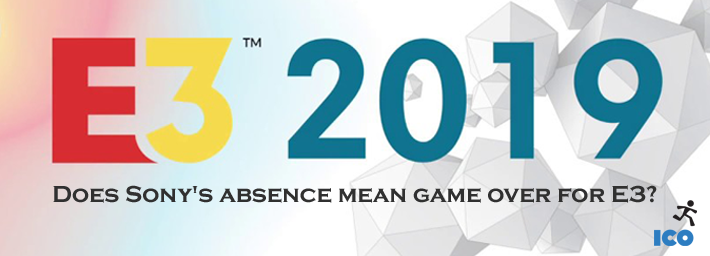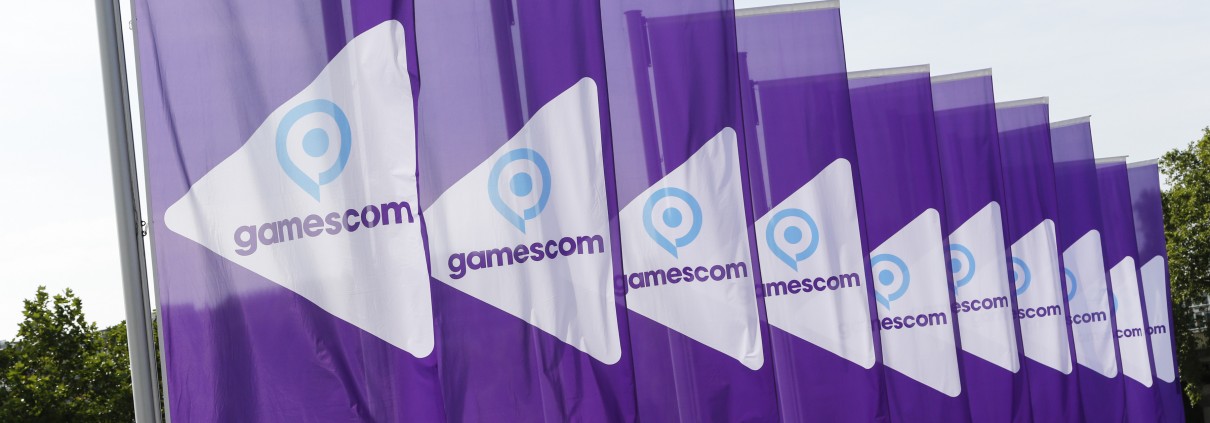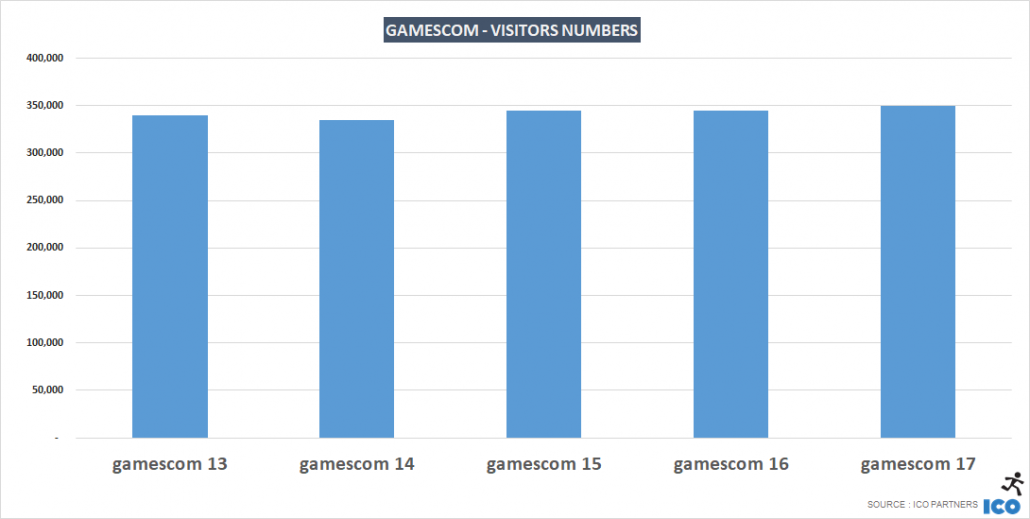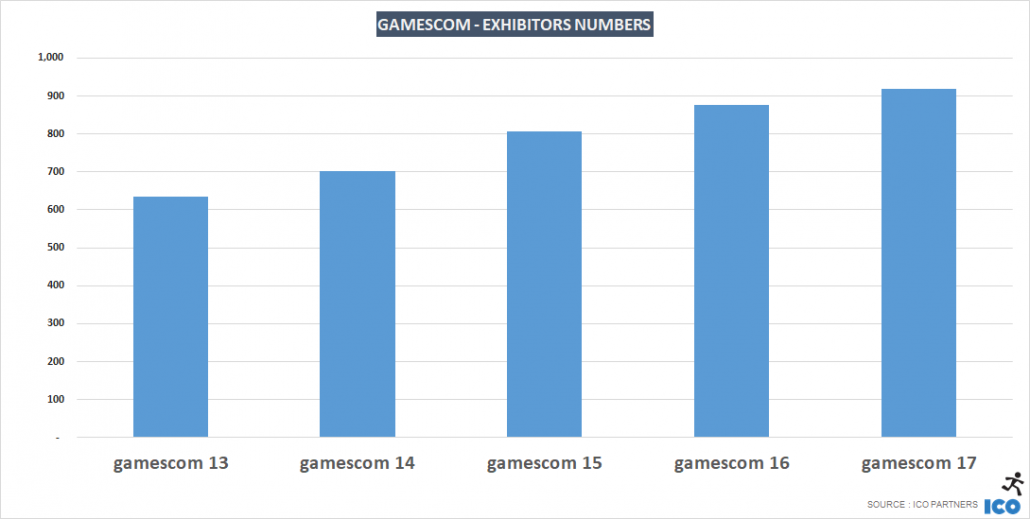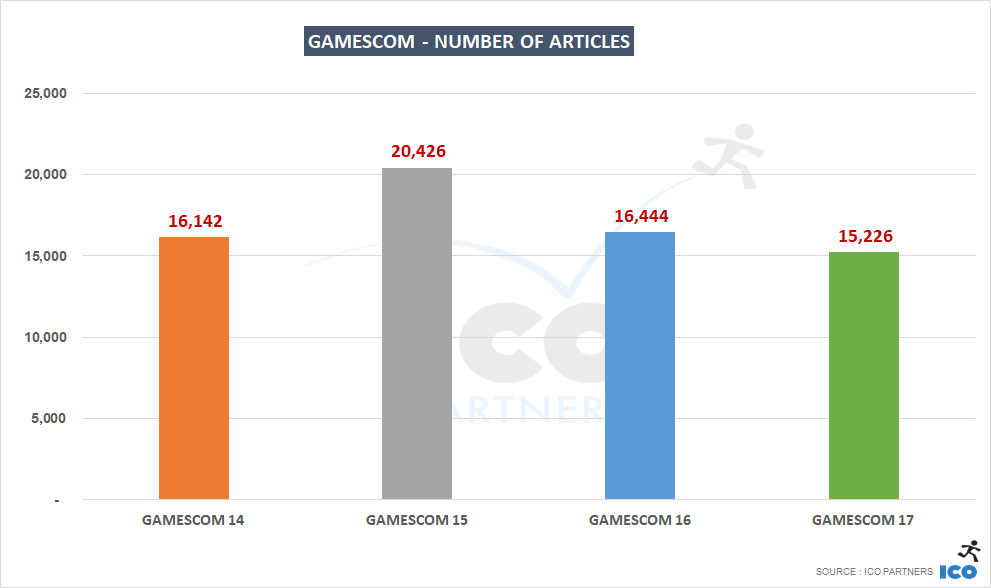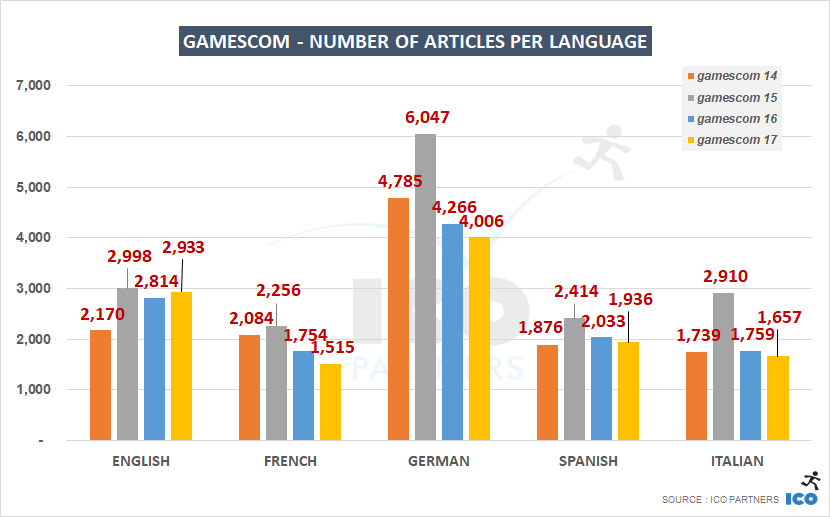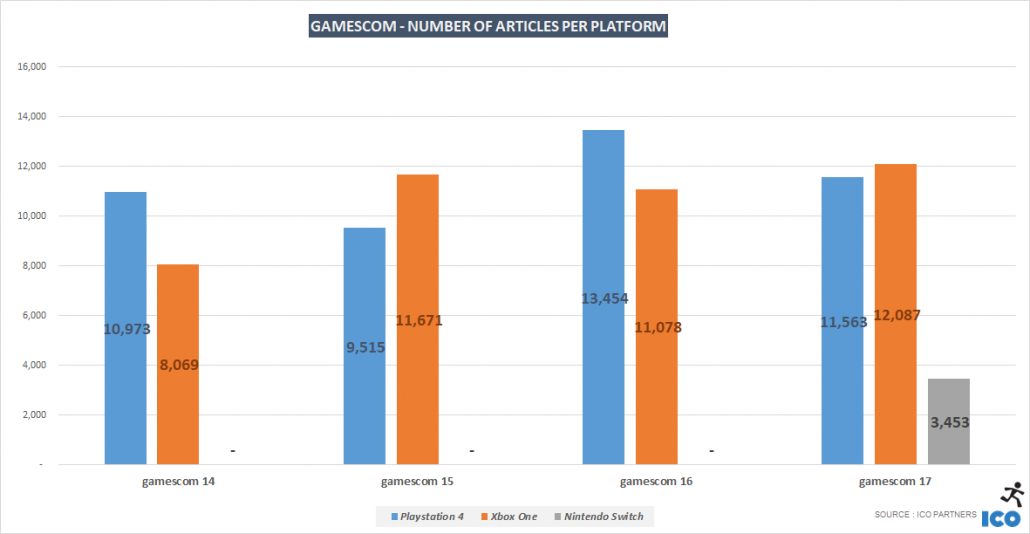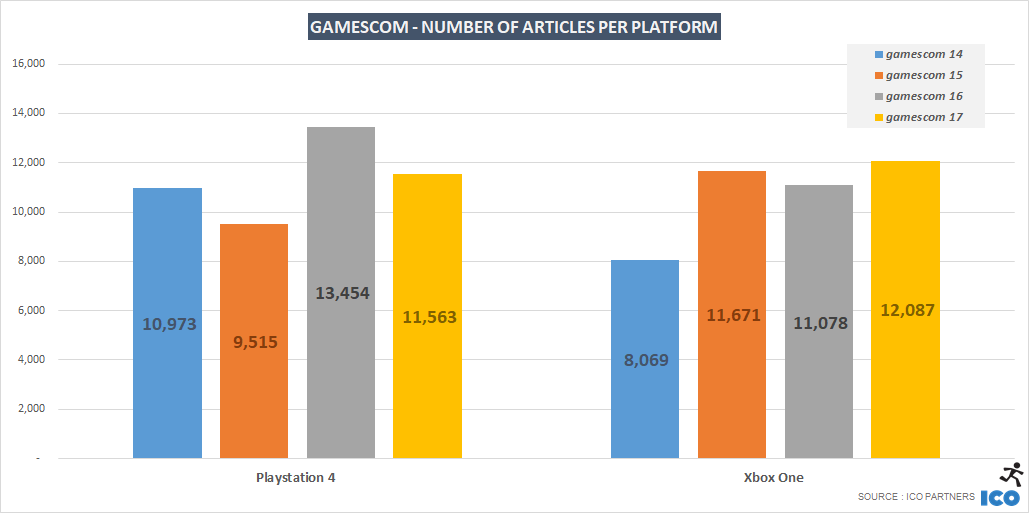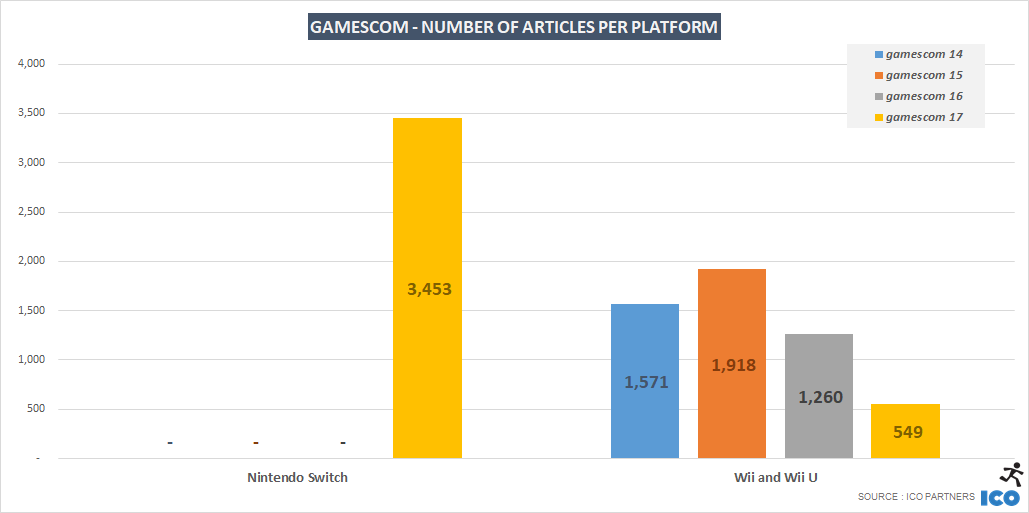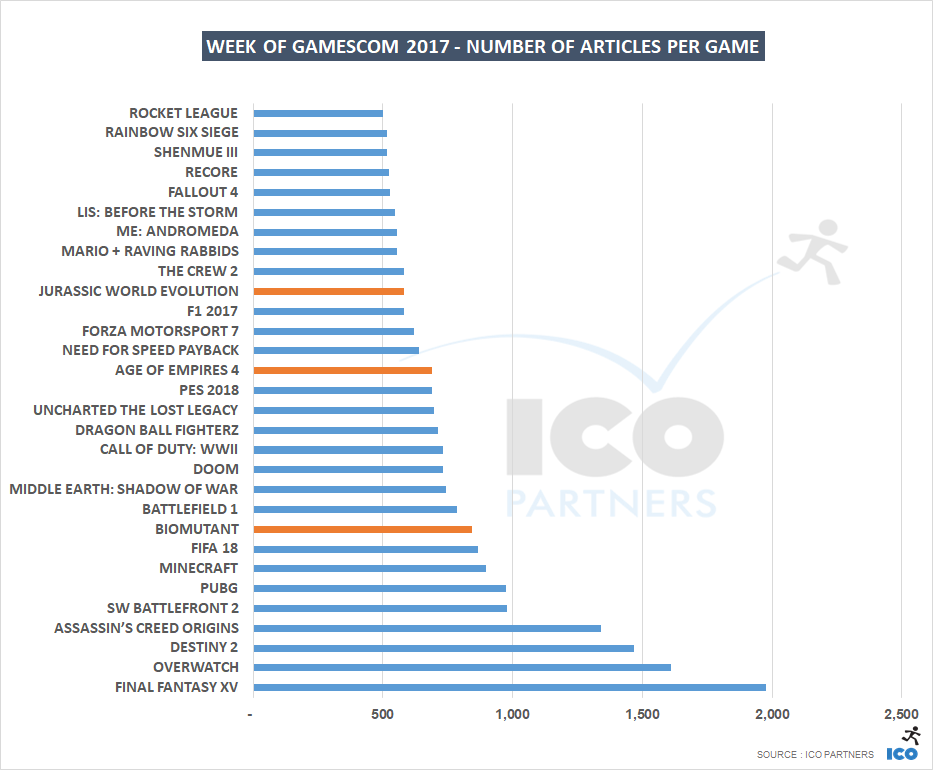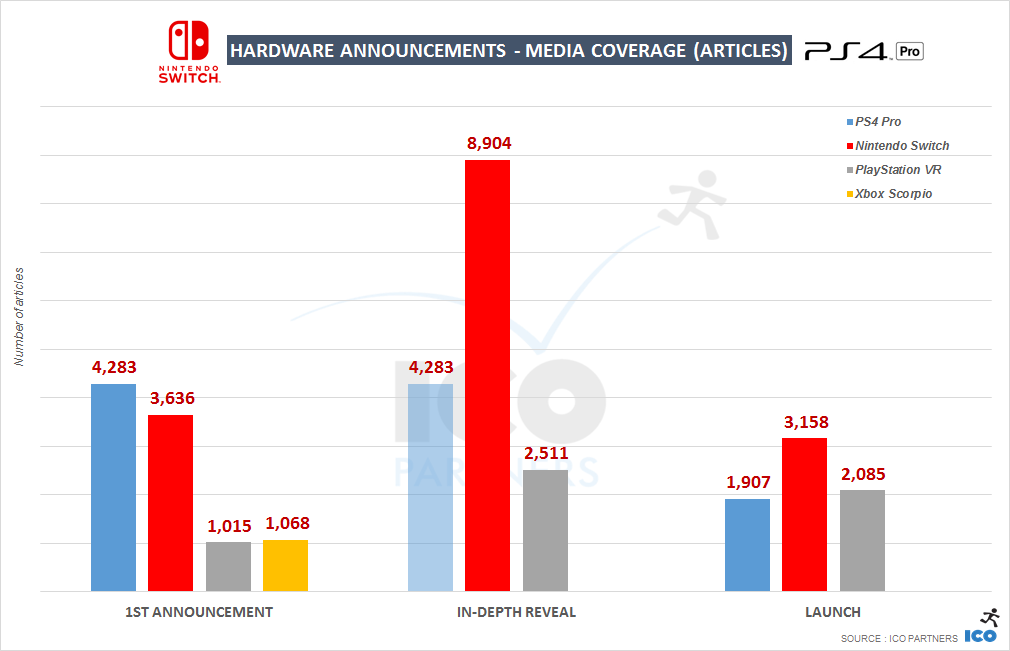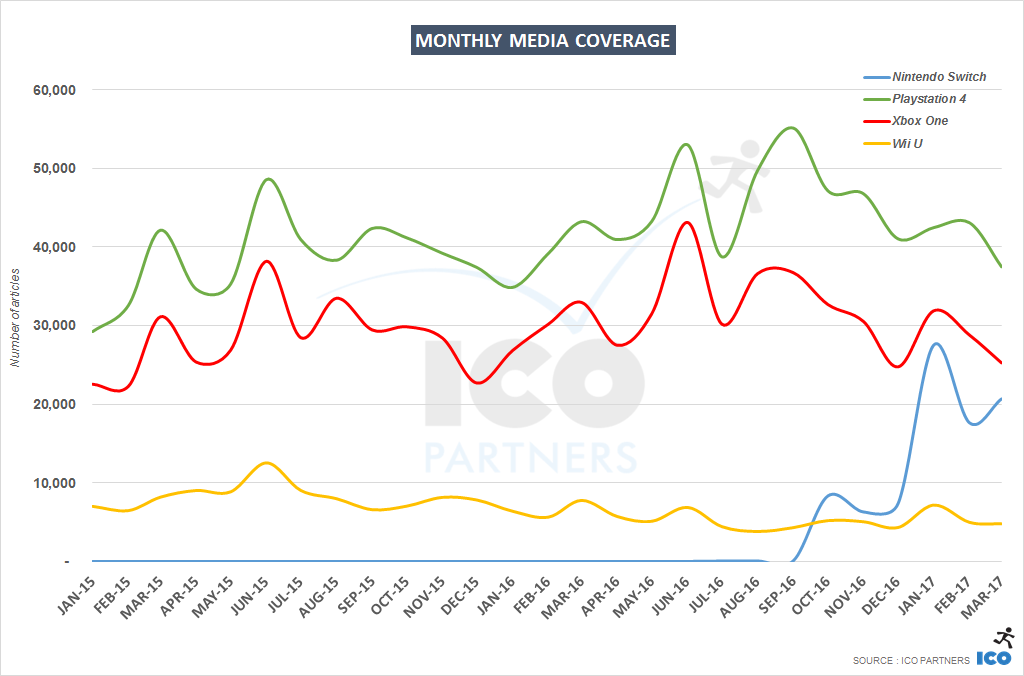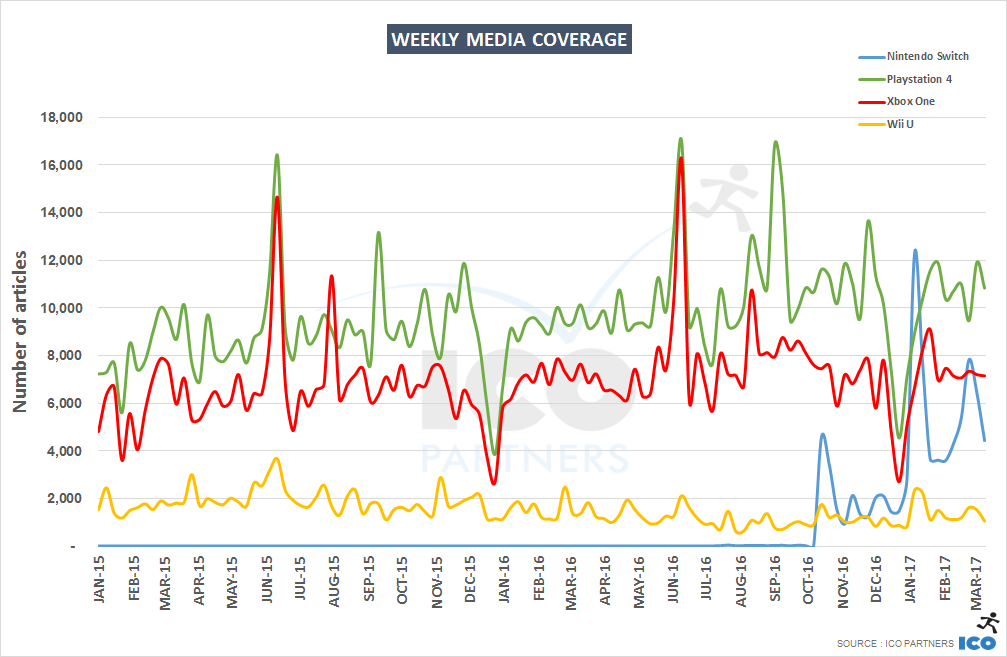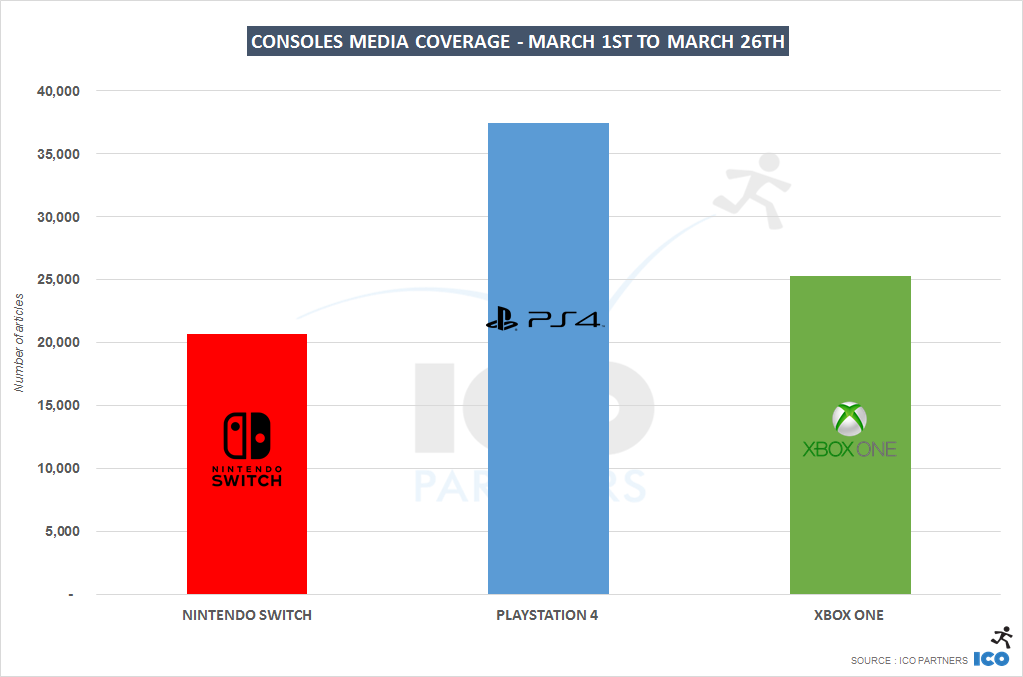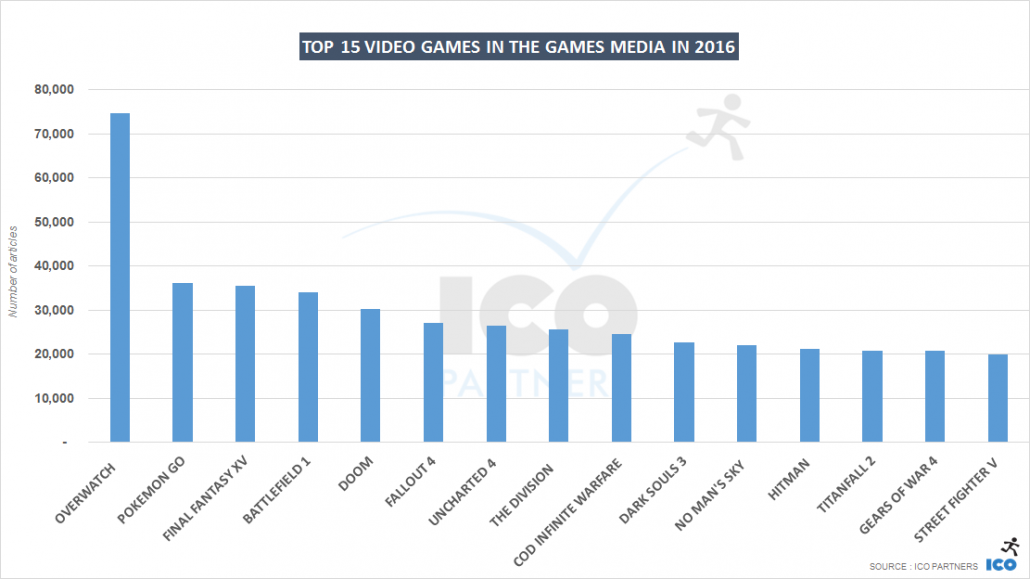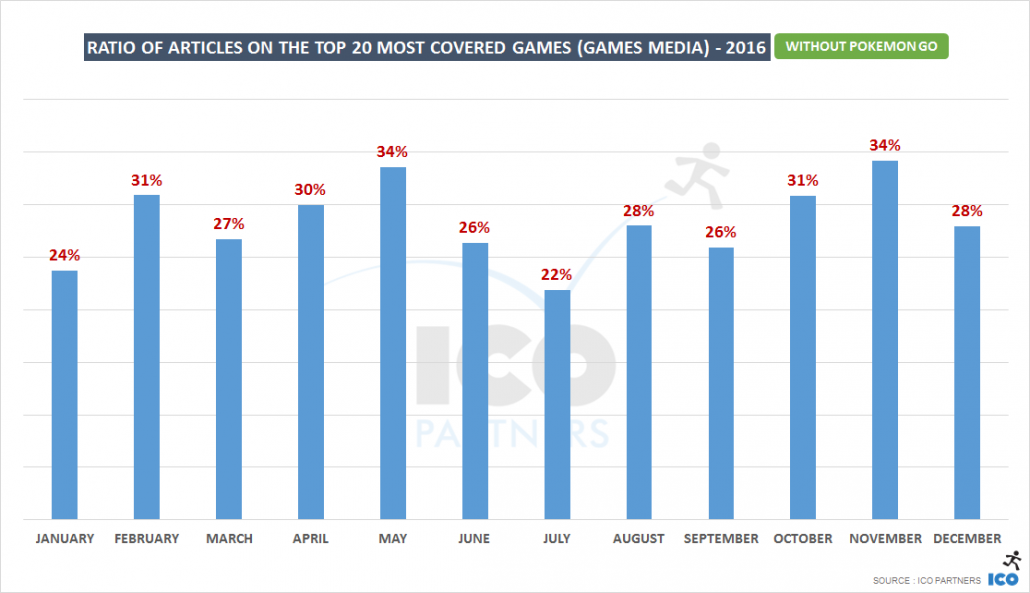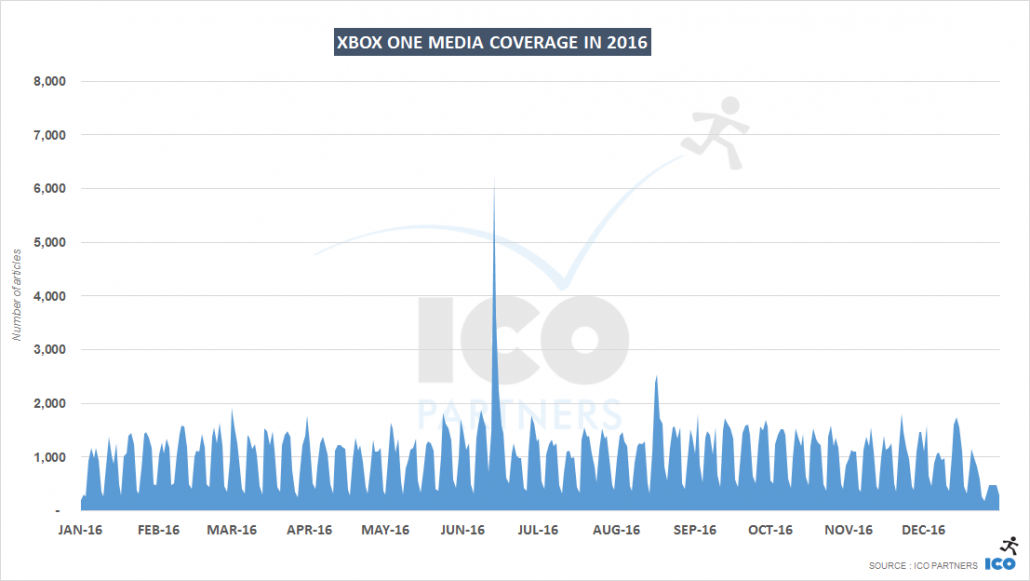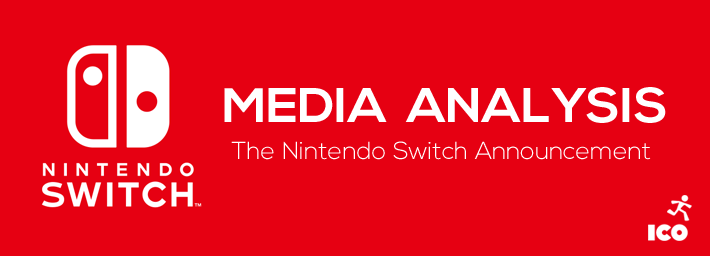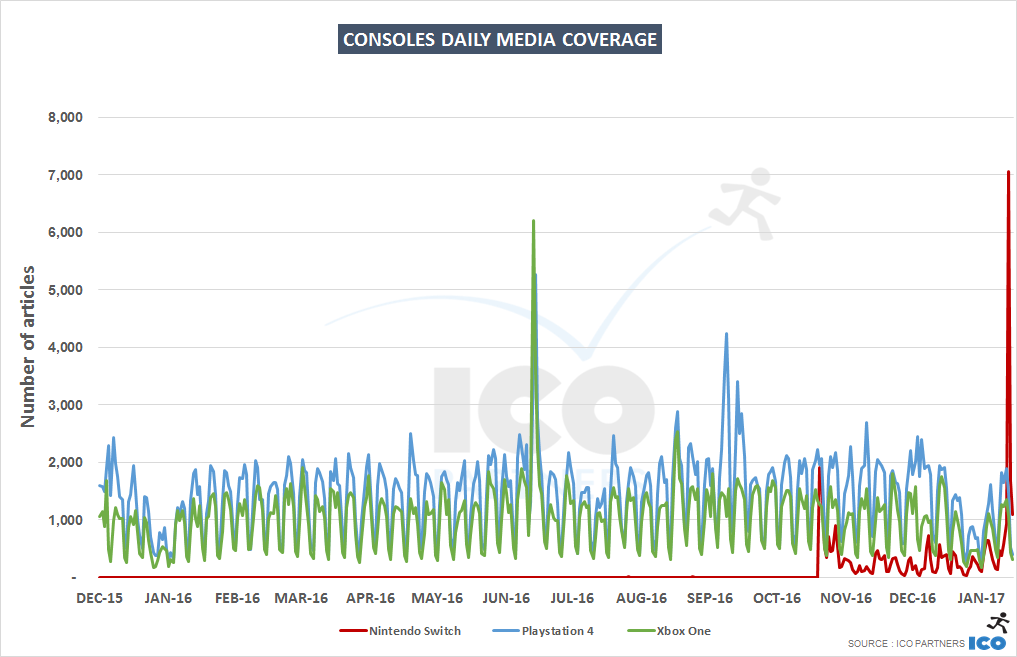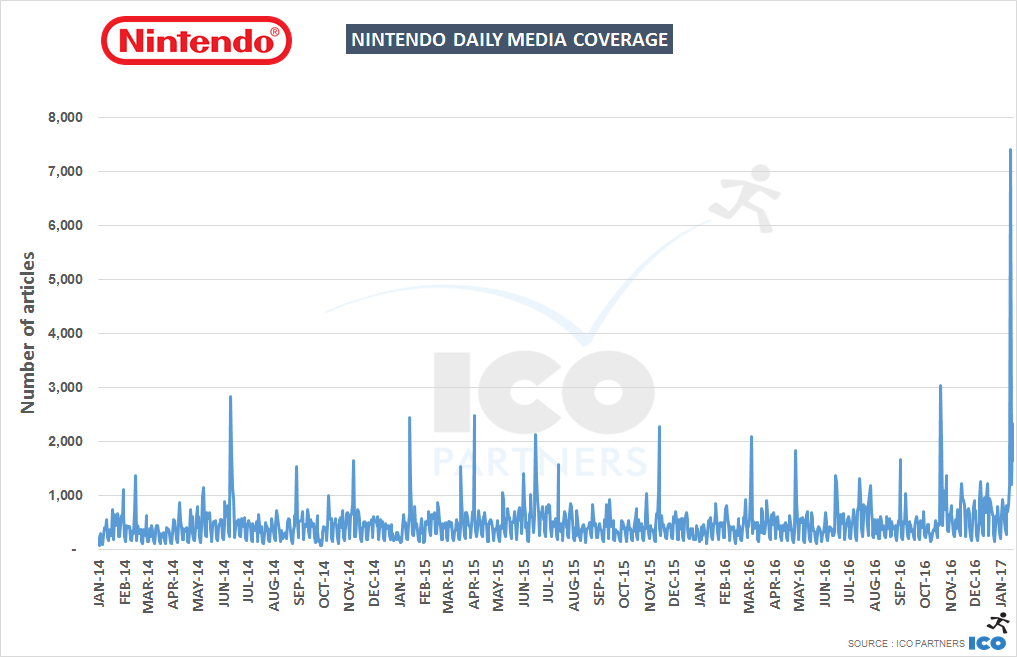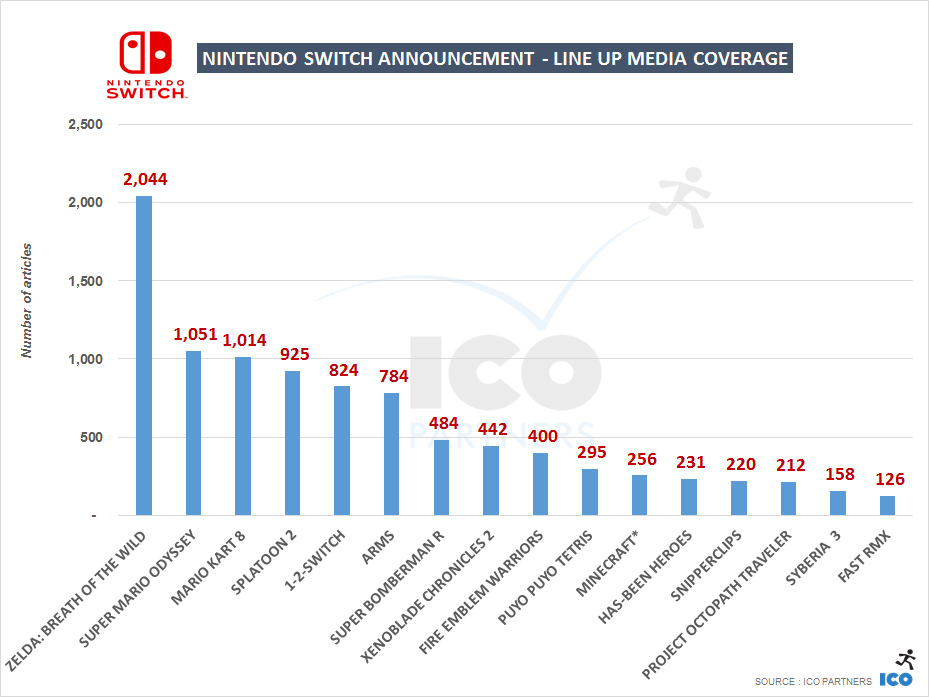The dust has settled on E3 2019, and it’s time for me to grab my Excel and run the coverage numbers from this year’s show. Read more
Posts
This is the yearly look at what is the most important game event in Europe, and the coverage it has generated around its latest edition. Read more
This is the week after gamescom, and as is tradition, I have some numbers to share about the event. I will reference data from previous years (some slightly adjusted), as this exercise has been done now for 2014, 2015 and 2016.
gamescom 2017
New dates
As for the last 3 years in a row, the dates have changed, with gamescom roughly a week later than the previous year. Moreover, it now starts on Tuesday instead of Wednesday, and ends on the Saturday rather than the Sunday. For professionals (at least the ones coming from Europe), it has the advantage of covering the work week, you can easily be back home on Friday.
Press Conferences
Microsoft kind-of had a press event? It was more similar to the Nintendo Direct format, with no onsite event, just a live video event being streamed. For reference, the last time Sony had a press event at gamescom was in 2014; while Microsoft skipped last year.
The Microsoft event seemed very weak to me. They only announced one new game for Xbox, Jurassic World Evolution, and it is not a very strong fit for a console genre-wise. They actually held their best game announcement for the following day, revealing a new Age of Empires is coming. The limited Scorpio edition also got decent coverage, but it seems to me it is more a sign of how light the event was in content.
Numbers
I went and pulled the attendance numbers from the previous years, to see how gamescom is doing in that regard. You can find the 2017 numbers here.
gamescom is not growing much. It seems to have reach its critical mass a few years ago now. I was wondering if the change of dates, especially not having the Sunday anymore, would impact the attendance numbers negatively, but it seemingly had no effect, or it might have even helped that slight growth in attendance.
Trade visitors is also very stable, even if lower than the peak seen in 2015. 30,000 professionals attending is quite impressive, it has to be said.
The number of exhibitors though is ever increasing. The multiplication of smaller companies (indie studios; micro publishers; other vendors) is probably at play here.
There are also the odd exhibitors, whose presence is always a bit confusing:
https://twitter.com/icotom/status/899550107779178497
gamescom in the media
This year’s edition of gamescom was relatively underwhelming when it comes to strong media beats (new games; high profile announcements; trailers on high expectation games) – and the media coverage would reflect this.
gamescom 2017 has seen the worse performance where media coverage is concerned since I started tracking it in 2014. Arguably, the numbers stay in the same range as the ones of 2014 and 2016, but it seems like on one hand Microsoft didn’t put any real show with its media event; while on the other hand no one picked up on the opportunity that gamescom represents.
Looking at the volume of media coverage per languages, it is interesting to see the past trend of increased visibility of the event with English media continues. The drop of German coverage (both in volume of articles and number of media) is intriguing and might be the results of a shift in the German media landscape.
The Platforms
With Xbox having an extra dedicated event, it should not be surprising that it secured more coverage during the week of gamescom, regardless of how weak the announcements there were. Xbox One X is getting a lot of attention as the newest hardware to be available, and the games supporting it got their fair bit of coverage.
Despite 2017 being weak overall, it is the best gamescom for Xbox since I started tracking media exposure. I find it very interesting that at the Cologne Messe, in the public area, the Xbox booth was actually quite small again. Microsoft seems to be careful with their spending there, at least for the second year in a row. Both Nintendo and Sony had vastly larger spaces, but even major publishers, or game studios had more space. It seemed to me that the Farming Simulator’s booth was only a third of Xbox’. And the Wargaming booth, also in the same hall, was probably twice as big.
Despite this being a good year, I can’t help and wonder how much it could have been for Microsoft with a stronger line-up of reveals considering their performance with their half-hearted presence.
Rather than compare the media performance of the Switch to the PlayStation 4 or the Xbox One, I found it much more interesting to present it compared to the Wii and Wii U coverage of previous years. Like at E3, Nintendo is really ramping compared to during the Wii era. This weeks Showcase was also very interesting on the indie front, and should contribute to Nintendo media coverage growth.
The Games
Games in orange were the ones first announced during this gamescom (arguably, Biomutant leaked a few days earlier).
Like last year, these were the top 30 games based on their media coverage. Here are a few thoughts:
- Final Fantasy XV had multiple announcements that week, taking it to the lead in coverage. Interestingly, it was also a top game last year.
- Overwatch is still very strong in the media. Blizzard is quite careful about always having announcements to make during gamescom, and it is paying off.
- Playerunknown’s Battlegrounds took a while to build its media presence. The Xbox One port is certainly helping, but the general strong interest in the title is putting it firmly on the list of media darlings, in a similar way to Rocket League.
- Biomutant’s strong media presence is proving that gamescom is an excellent opportunity for publishers with less muscle than the publishing powerhouses using E3 as their main media event of the year.
- Jurassic World Evolution and Age of Empires IV, the two new titles announced by Microsoft, secured a significant amount of coverage, but nothing actually crazy. Most of Microsoft media coverage was around the titles supporting the new Xbox One X, rather new games.
Closing Words
Next year, gamescom’s dates are for once not changing. They keep the Tuesday to Saturday formula, at the end of August. It will be interesting to see if more companies decide to use it as a springboard to announce new titles, following the steps of THQ Nordic’s Biomutant.
Post-Scriptum – If you have been following us for a while, you might have recognized Martin Rabl, an ICO alumni, on the coverage of Angela Merkel’s visit of gamescom:
This just happened! My pulse is slowly getting back to normal. 🙂 #farmingsimulator #gamescom #Merkel pic.twitter.com/5yOdZJIOEe
— Martin Rabl | Amboss (@martin_rabl) August 22, 2017
This is the third article of media coverage analysis for the Nintendo Switch, but it’s the most important one as the console has now been released. While I will discuss previous announcements, you can read again the posts about the console’s first announcement and the January event that revealed most of the details about it.
The console has now been widely available for 3 weeks, and we can look at both the announcement, and some level of data over time, to see how it looks for this new console.
Hardware Coverage Comparison
With our data only going back to early 2014, there are no comparable launches to compare the Nintendo Switch with. For lack of better comparisons, I had a look at the coverage of the first announcements for the PS4 Pro, the PS VR and the Xbox Scorpio, and the coverage of the launches of the PS4 Pro and PSVR.
The PS4 Pro initial announcement was during a Sony event, and set out a lot of details for the new machine. The way the communication was structured for it, there was a short cycle between the announcement and the launch (2 months), and the fact the announcement was done outside of other industry events allowed it to garner significant coverage. The initial announcement also served as in-depth reveal for that matter.
The PSVR initial announcement (as project Morpheus at the time) was done during GDC 2014, and was still very vague on any details. That first reveal wasn’t massive with media coverage. Interestingly, 2 years later, at GDC 2016, the reveal of the details of the device and its price point was its biggest beat.
Project Scorpio (next Xbox One iteration) was first announced during E3 2016, and beyond the fact it would have the highest quality pixels that anybody has seen, Microsoft didn’t provide many details during the announcement. We are basically still waiting for the device’s in-depth announcement, which is likely to be at this year’s E3, leading to a launch before the holiday season.
The communication on the Nintendo Switch was very controlled, and beyond the initial announcement and the in-depth reveal, there were no real major beats before the launch. The only other communication was earlier in the week of the launch with a number of indie titles announced (some officially by Nintendo and a good number of others announced by their respective publishers).
So, what does it mean for the Nintendo Switch announcements and launch?
First, launches are not as exciting as the reveals of the details of the console. By the time they hit the market, the story is a bit dull and generally consists of a reminder of what the console is, probably its line up and the fact that “yes, you can buy it now”. The fact they don’t garner as much coverage as the in-depth reveals despite having a line-up of games immediately available that also should drive coverage seem to highlight that media still prioritise hardware news over games. In that respect, the media coverage of the Nintendo Switch, while significantly higher than the other two devices we can compare it to, is nothing incredibly impressive. The fact is, there were fewer articles mentioning the Nintendo Switch than the PlayStation 4 on the days of the launch, and that’s probably a direct consequence from the small line-up on the Switch, and the impressive head-start Sony has when it comes to media relations.
Second, in-depth events are the ones that matter the most to get coverage. Is it obvious? Absolutely, but I think you should always approach analysis with an open mind and getting evidence of the obvious is still a good take away. What is also very interesting is the relative success of this reveals. The Nintendo Switch being in January, outside of any events, and being quite close to the actual launch, really paid off in my opinion there for Nintendo.
To get a better sense of the Nintendo Switch potential for media coverage, let’s look at coverage over time, rather than at scheduled events.
Console coverage patterns
[please note that all the data presented here is as of March 26th – all monthly data labelled as March 2017 are until that date]
I have added the Wii U to the mix from the graph over time as I think it is essential to understand where Nintendo is coming from in terms of their console media coverage.
So what is transpiring here:
- As we mentioned many times before, the PlayStation 4 is the clear leader when it comes to console media coverage, and this is a constant. Even when looking at the weekly coverage volumes, since January 2015, only once did the Xbox One secure more coverage than the PlayStation 4. It was the week of the gamescom 2015, where Microsoft held a press conference and Sony did not. The gap between the two is actually widening over time.
- Microsoft doesn’t seem to be learning from Sony when it comes to making big announcements outside of major industry events. Or even outside of E3. That dependence on E3 seems like a very risky strategy. Yes, E3 is still clearly the most important event of the year when it comes to coverage of the video games industry, but at the moment, Microsoft is not learning how to also do announcements at other times. Sony’s September event drove coverage to the level of their E3 weekly coverage, and when it comes to monthly coverage, it was their best month since we started tracking the articles mentioning the PlayStation 4. The Xbox One’s best month was June and E3.
- The Wii U has been lagging behind the other consoles for a long time now. The decline is clearly visible, and even a major release like Zelda Breath of the Wild doesn’t seem to have much of an effect – it is clear the console is a very low priority for the media. Again, this is not an unexpected result, but we can now see the scale of it.
- The Nintendo Switch is having an excellent start. Of course, a lot of that coverage is thanks to the January in-depth reveal that got really good coverage, and the momentum of the launch, but for a console with such a limited line-up, it seems that there is significant interest for the console, outside of just the launch. If the average weekly coverage stays around 4,000 articles/week, that puts it a bit above half of the Xbox One weekly average and at 40% of the PlayStation 4 weekly average, which would be an excellent foundation for Nintendo to build on.
Conclusion
Nintendo is getting a new console cycle, and the media seem to be keen on supporting it for now. It has a long way to go still, but they didn’t make any significant mistakes so far, and despite a very small launch line-up they secured a decent amount of coverage, and the poor interest for the Wii U doesn’t seem to have damaged the interest for the Switch. They also seem to have learned to make their announcements on their own time and not let major events dictate their calendar. Interestingly, they have just announced that they are planning a “big E3”, which is probably the next important series of announcements for them to get right to stay relevant and present in the media.
To complete the usual series of blog posts reviewing the past year, I present to you 2016 and video games in the media.
Like last year, bear in mind that we are using our internal tool to collect these numbers, and understanding the methodology is important. It is particularly worth mentioning this year Pokemon Go is definitely making things crazy. Or crazier than usual I should say. In order to account for that, a lot of the numbers presented here are limited to video games media. We do have General Interest and Tech media in our tools, but they are not as exhaustively collected on our end.
Games
Let’s address Pokemon Go now. I wrote about the game shortly after the launch, and while things have calmed down since July, the game is still receiving an impressive amount of coverage daily, even at times where there is no new update to discuss.
This being said, it wasn’t the number one game mentioned in the games media (important to be specific here), that was Overwatch.
Pokemon Go, while announced in September 2015, received very little coverage until it launched in early July 2016. The amount of coverage collected here is basically only 6 months worth, where Overwatch was already well covered prior to its launch in May.
If we compare these numbers to the ones from last year (which take into account a wider range of types of media), Pokemon Go’s performance is striking as it is a Nintendo game (only Splatoon managed to barely get in the top 15) and a mobile game (there were none in that ranking in 2015).
Overwatch is also impressive as it had 50% more coverage than any game in 2015. The online nature of the game, with its constant updates, coupled with the power of the Blizzard brand, pushed the game to the top here, making it by far the game with the most media presence in 2016.
Overwatch is also striking in the sense that it is one of the only two new IPs in this ranking (The Division being part of the Tom Clancy’s franchise), alongside No Man’s Sky. Many industry commenters pointed to No Man’s Sky’s hype as being the main reason for its fall from grace, and you have to give them credit here, when you see the game is in the top 15 most covered by media game of the year, while coming from a small independent studio. Even the Sony PR machine can’t be the only thing at play here, as many very large productions didn’t manage to make it in these rankings. The game’s hype took on a life of its own, and got big.
For the fans of the respective series, it will interesting to note that Battlefield 1 secured about +40% more coverage than this year’s Call of Duty game. Year-on-year, Call of Duty’s media coverage dropped about -12%.
Monthly Data
For a very long time, we wanted to run these numbers. As ICO is also a PR agency, a lot of the discussions with the studios and the publishers come around to the best timing to do a particular communication. The above is a great way to understand when certain periods are swamped, while some are on the contrary very light.
You’ll see that I removed Pokemon Go from the data. The game was so dominant at its launch that it was skewing the data (more than 7% of the articles in the games media in July 2016 mentioned Pokemon Go). Removing it is not a perfect solution either, but it draws a slightly better picture.
There are different ways to understand these numbers, but here are my takeaways:
- You probably want to communicate when the ratio of articles for AAA is lower. It means the coverage is more varied and more likely to be covering your game. From that perspective, November is often deemed a tough month for communications, and both graphs illustrate this well.
- When there is a lot of coverage, you also have more chances to be covered, however, the communication will also stand out less as higher volume of articles means more noise overall. In that sense, communicating during the E3 period (June) can be a blessing and a curse at the same time.
- While media coverage does drop during the Christmas period, it is the only time in the year where there is a visible drop in the volume of coverage across all media. It means that any other time, there will always be a minimum number of articles that need to be written, and it can pay off to aim for the periods outside of the AAA games releases, like January or July.
While making these graphs, the question came up about the number of games beyond those top 20 games. The truth is, we don’t know how many games communicate in any given month. We do know how many games are released on Steam on average, and this is where the 500+ number comes from. In reality, you can expect all the games releasing to have some form of communication that month, but you would also need to add all the games that are announced, the games that are communicating about their upcoming release, the released games having some newsworthy announcement, like an expansion, or a DLC release, not to mention the live games with significant updates.
That 500+ figure for games is quite conservative in truth.
Platforms
2016 was interesting as far as platforms are concerned. While there were no new console coming out, there were upgrades, iterations and major accessories announced and released. The Playstation 4 and the Xbox One are hitting their stride while the Wii U is in its last year being the main console for the Nintendo line up, with the Switch being around the corner.
What is interesting in the media coverage is the fact that it was yet again a strong year for the Playstation 4, with even more media coverage than in 2015 (+14%). The console has established its lead, the media follow the trend. The PlayStation VR and the Playstation 4 Pro both helped bring the device in front of the media as well.
For Xbox One, it was also a good year compared to 2015 (+18%), a growth in coverage not necessarily being a given considering the most important announcement, Project Scorpio, related to a new version of the console to be released in 2017.
The Wii U year-on-year numbers see a steep decline overall (-24%). Comparing it to the Oculus Rift, which is a niche platform that had its first release in the year both shows how much Oculus has accomplished, and how much the Wii U has dropped.
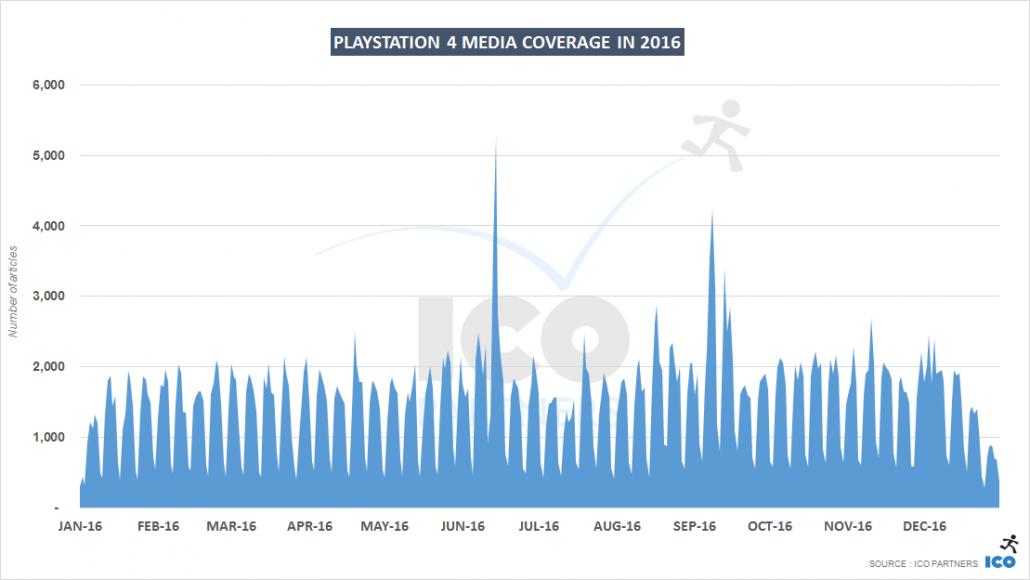
Sony’s communication strategy is well established by now, with most of its coverage originating from E3 and a combination of their own events and industry conferences.
gamescom, despite the absence of a press conference, is still an important source of coverage overall, but it does come after the press event ahead of the Tokyo Game Show.
And like last year, the Playstation Experience event in early December was a tremendous success for Sony as far as media coverage is concerned.
The Microsoft coverage over the year has fewer events sparking spikes in coverage. The two most notable ones are the E3 in June, and gamescom in August, even though, like Sony, they didn’t put a press conference together in 2016.
Microsoft seemed to be on the defensive in its communication strategy the whole of 2016 and the fact it still managed to grow the coverage is a good sign. Hopefully they will be more aggressive this year, with the Project Scorpio device coming, to shake things up a bit.
Back in October, I did an analysis of the announcement of the Nintendo Switch. It was a rather short one, with very few details shared at the time, with the promise of a more in depth presentation following an event in January. That event was last week, and now is a great time to look at how it went for the Nintendo teams.
The Console
There is no question that, of the three console manufacturers, currently Nintendo is lagging behind Sony and Microsoft and that is very apparent when looking at the media coverage of each console.
In the video games media landscape report that we shared last year, Nintendo received less than a third of the articles that PlayStation had. In that respect, the Switch announcement seems to have been fairly well covered. We are lacking data to compare it with other console announcements, though.
Here is another graph to illustrate how significant the event was for Nintendo’s coverage:
While it is not surprising that the main event showcasing a new console is the single biggest media event for Nintendo in the past 3 years, the scale it reached is significant. It is the single biggest announcement in terms of volume of coverage across all 3 main consoles for that period of time. For Nintendo, a company that is struggling to compete with the media attention its two contenders receive, it looks like a massive achievement.
And with the new cycle of consoles being upgrades from the current gen, rather than brand new iterations, this might stay true for a while for all we know.
Games
* Minecraft numbers are only for articles explicitly naming the Switch and Minecraft.
Looking at the games announced at last week’s event, there seems to be 4 categories:
- Zelda is alone in the lead, with twice as many articles as any other games. Nothing surprising here: it was the crown jewel of the line-up, the game that was playable on-site, and it’s the one key launch title for the console. It is interesting to note though that it is garnering even more coverage than at last E3, where it was one of the leading game in terms of coverage (2,300 articles over a week compared to 2,600 articles since Friday)
- Nintendo’s first party titles – they benefited from the full support of the firm’s communication effort. It’s also interesting to note that existing licences are performing better than the new brands. This is very normal of course, but interesting to actually see it in numbers.
- 3rd party titles from key Japanese licences – I put in this bucket Bomberman, Fire Emblem and Xenoblade, that all received 400+ articles from the event.
- Other 3rd party titles – this is of course more varied and spread out, but I think it’s worth noting Snipperclips and Octopath both securing more than 200 articles – no small feat for projects with their profiles.
That’s it for me (for now).

